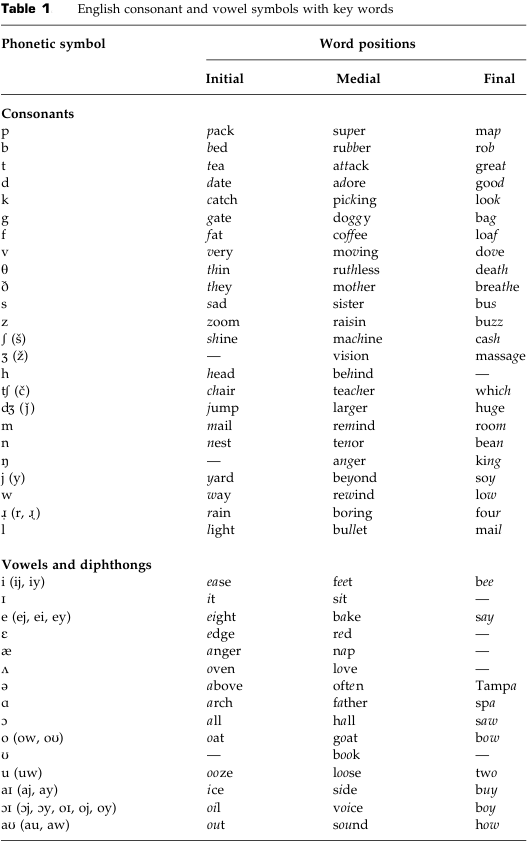


 Grammar
Grammar
 Tenses
Tenses
 Present
Present
 Past
Past
 Future
Future
 Parts Of Speech
Parts Of Speech
 Nouns
Nouns
 Verbs
Verbs
 Adverbs
Adverbs
 Adjectives
Adjectives
 Pronouns
Pronouns
 Pre Position
Pre Position
 Preposition by function
Preposition by function 
 Preposition by construction
Preposition by construction
 Conjunctions
Conjunctions
 Interjections
Interjections
 Grammar Rules
Grammar Rules
 Linguistics
Linguistics
 Semantics
Semantics
 Pragmatics
Pragmatics
 Reading Comprehension
Reading Comprehension|
Read More
Date: 2023-11-20
Date: 7-6-2022
Date: 19-7-2022
|
Phonetic Transcription
Because we are constantly involved with reading and writing in our daily lives, we tend to be influenced by the orthography when making judgments about the sounds of words. After all, from kindergarten on, the written language has been an integral part of our lives. Thus, it is very common to think that the number of orthographic letters in a word is an accurate reflection of the number of sounds. Indeed, this is the case for many words. If we look at the words pan, form, print, and spirit, for example, we can see the match in the number of letters (graphemes) with the number of sounds: three, four, five, and six, respectively. However, this match in number of graphemes and sounds is violated in so many other words. For example, both though and choose have six graphemes but only three sounds. Awesome has seven graphemes and four sounds, while knowledge has nine graphemes and five sounds. This list of non-matches can easily be extended to thousands of other words. These violations, which may be due to ‘silent letters’ or a sound being represented by a combination of letters, are not the only problems with respect to the inadequacies of orthography in its ability to represent the spoken language. Problems exist even if the number of letters and sounds match. We can outline the discrepancies that exist between the spelling and sounds in the following:
The same sound is represented by different letters. In words such as each, bleed, either, achieve, scene, busy, we have the same vowel sound represented by different letters, which are underlined. This is not unique to vowels and can be verified with consonants, as in shop, ocean, machine, sure, conscience, mission, nation.
The same letter may represent different sounds. The letter a in words such as gate, any, father, above, tall stands for different sounds. To give an example of a consonantal letter for the same phenomenon, we can look at the letter s , which stands for different sounds in each of the following: sugar, vision, sale, resume.
One sound is represented by a combination of letters. The underlined portions in each of the following words represent a single sound: thin, rough, attempt, pharmacy.
A single letter may represent more than one sound. This can be seen in the x of exit, the u of union, and the h of human.
One or more of the above are responsible for the discrepancies between spelling and sounds, and may result in multiple homophones such as rite, right, write, and wright. The lack of consistent relationships between letters and sounds is quite expected if we consider that the alphabet English uses tries to cope with more than forty sounds with its limited twenty-six letters. Since letters can only tell us about spelling and cannot be used as reliable tools for pronunciation, the first rule in studying phonetics and phonology is to ignore spelling and focus only on the sounds of utterances.
To avoid the ambiguities created by the regular orthography and achieve a system that can represent sounds unambiguously, professionals who deal with language use a phonetic alphabet that is guided by the principle of a consistent one-to-one relationship between each phonetic symbol and the sound it represents. Over time, several phonetic alphabets have been devised. Probably, the most widespread is the one known as the International Phonetic Alphabet (IPA), which was developed in 1888, and has been revised since then. One may encounter some modifications of some symbols in books written by American scholars. We will basically follow the IPA usage while pointing out common alternatives that are frequently found in the literature. First, we will present the symbols that are relevant to American English (see table 1) and later we will add some non-English sounds that are found in languages that our readership is likely to come in contact with.

The following should be pointed out to clarify some points about table 1 Firstly, certain positions that are left blank for certain sounds indicate the unavailability of vocabulary items in the language. Secondly, the table does not contain the symbol [ʍ] (or [hw], [W̥]), which may be found in some other books to indicate the voiceless version of the labio-velar glide. This is used to distinguish between pairs such as witch and which, or Wales and whales. Some speakers make a distinction by employing the voiceless glide for the second members in these pairs; others pronounce these words homophonously. Here, we follow the latter pattern. Finally, there is considerable overlap between final /j/ and the ending portion of /i/, /e/, /aɪ/, and /ɔɪ/ on the one hand, and between final /w/ of /o/, /u/, and /aʊ/ on the other. The alternative symbols cited make these relationships rather clear.
|
|
|
|
التوتر والسرطان.. علماء يحذرون من "صلة خطيرة"
|
|
|
|
|
|
|
مرآة السيارة: مدى دقة عكسها للصورة الصحيحة
|
|
|
|
|
|
|
نحو شراكة وطنية متكاملة.. الأمين العام للعتبة الحسينية يبحث مع وكيل وزارة الخارجية آفاق التعاون المؤسسي
|
|
|